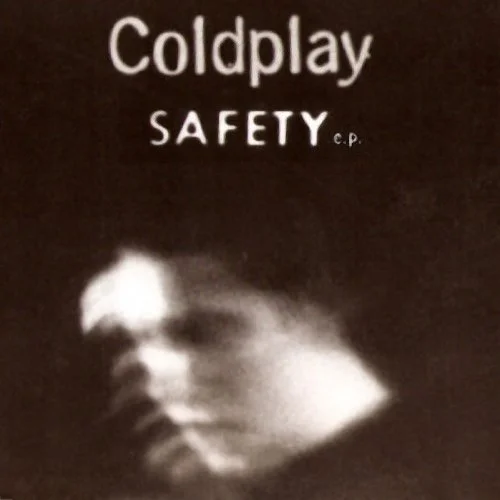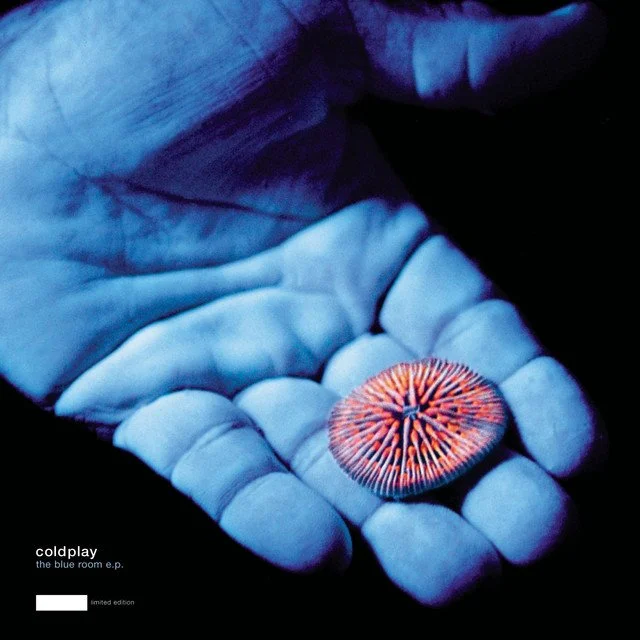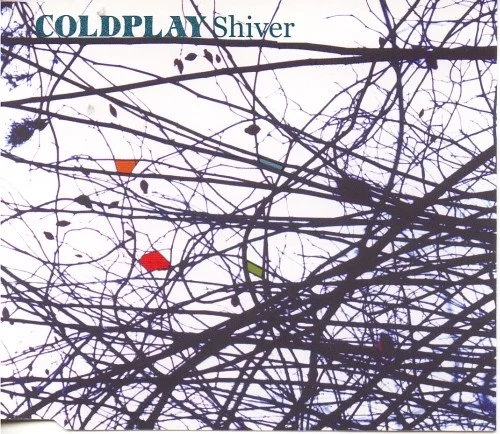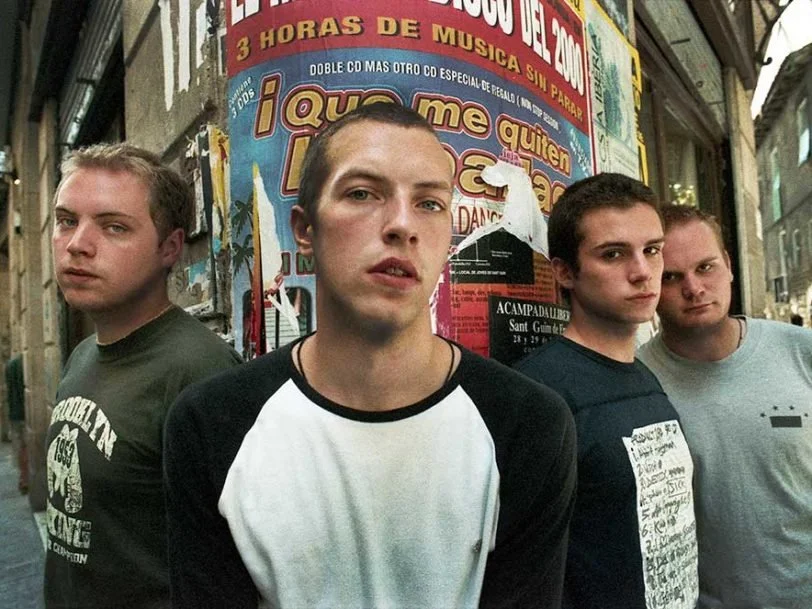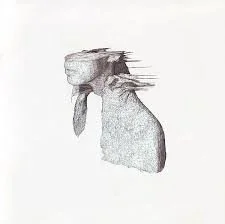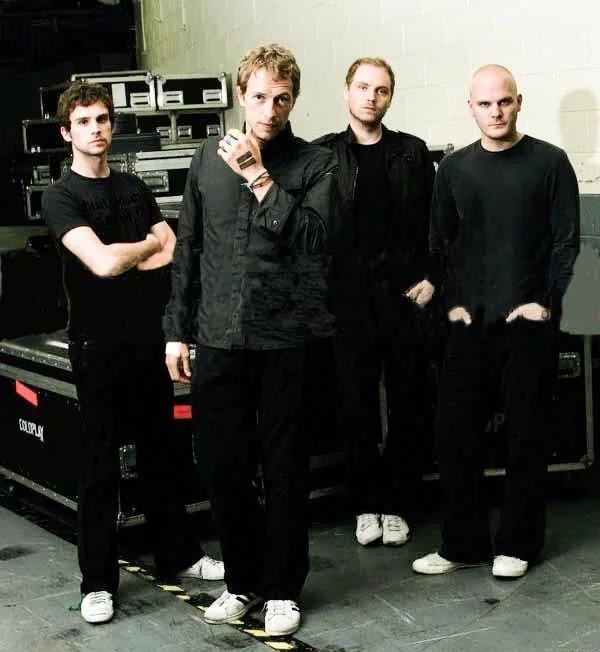No More Keeping My Feet on the Ground: A Deep Dive Retrospective of Coldplay, the early years
21st Century Music are playlists and write-ups that focus on artists that have released their music since 2000. These highlight new(er) acts that continue the sound and spirit of the older acts that are highlighted on Ceremony. Click on the streaming service of your choice below to listen to the playlist as you read along.
In the summer of 2000, there were two songs on the radio that seemed to inspire a resurgence of indie rock music after a relatively bleak period of the late 1990s. I linked them because of their return to basic instrumentation and strong melodic songwriting during a time of increasing focus on rhythms. Oddly, one would think there would be a reach for hope and energy at the dawn of a new millennium, but these songs were insistent and melancholic and that resonated. They were a pair of alt-rock hits (in Canada, at least) that channeled Britpop but without the attitude – a style that would come to be known as ‘twee.’ I instantly fell in love with the songs, bought the CDs, and played them constantly.
The Playlist
“No More Keeping My Feet on the Ground”
“Brothers and Sisters”
“Don’t Panic”
“For You”
“Spies”
“High Speed”
“Politik”
“A Rush of Blood to the Head”
“I Ran Away”
“Things I Don’t Understand”
“White Shadows”
“X&Y”
“Cemeteries of London”
“42”
“Yes”/“Chinese Sleep Chant”
“Major Minus”
The first of those songs was, “Why Does It Always Rain on Me,” by Travis. It was released in the back half of 1999, but it was the spring and summer of 2000 when I latched on to it. The other was “Yellow” by Coldplay, issued in June of 2000, a month before the band’s debut LP. I tracked Travis through their next album or two, but they faded out of sight for me (but caught them in concert recently and will definitely do a profile at some point). Coldplay, however, became a huge success and I rode their wave over the next several albums, seeing them in concert twice.
At the time of writing this profile in 2025, I would describe my knowledge of Coldplay as passing. I know they exist, I know they have a huge fan base and play to stadiums around the world (they just played four shows to nearly two-hundred thousand people in my home, Toronto, in a stadium built specifically to host them), have had a Super Bowl appearance and seem ready to retire their recording career. That’s it, that’s all I know about them as they exist today. So, what happened? How did they go from being one of my favourite bands of the early 2000s to an act in which I barely acknowledge? That trajectory is the theme of this profile, as we’ll track their first four LPs.
Appreciation of music is subjective. I will not say that Coldplay is worse now, because while I don’t like them, many others do. I am fascinated when artists move away from my tastes. There have been several like this in my experience and I’m sure you have your own. U2, The Cult, Simple Minds, Tears for Fears, and Sia are a few that come to mind for me. I often criticize artists for not evolving their sound, for being too anchored to a genre and sonic signatures. So, the risk is sometimes the move is away from my appreciation. Coldplay’s musical change certainly paid off, so I don’t think they’re sweating the loss of the likes of me.
Given Coldplay’s stature, we’re going to utilize the ‘deep dive’ Ceremony approach for this 20th Century profile. This playlist will feature less popular (relatively speaking) tracks to reveal the band’s music and leave the hits for your own exploration.
“No More Keeping My Feet on the Ground” \ Safety EP (1998)
“Brothers and Sisters” \ Non-album single (1999)
“Don’t Panic” \ The Blue Room EP (1999)
“For You” \ “Shiver” single (2000)
Coldplay is one of those rare acts that has sustained the same line-up since its founding. Formed in London in 1997, they have always been the same quartet of Chris Martin on vocals and keys, Jonny Buckland on guitar, Will Champion on drums, and Guy Berryman on bass. Martin and Buckland started together after meeting at college, adding schoolmates Berryman and Champion over the next year. After cycling through the band names Big Fat Noises and then Starfish, they settled on Coldplay, taken from a book of poetry by Philip Horky, Child’s Reflections, Cold Play.
In May of 1998, the band issued their first release, a three-track EP called Safety. “No More Keeping My Feet on the Ground” revealed the band already forging their indie-pop vibe. Somewhat expansive, with good instrumentation and hooky melodies, many elements of Coldplay’s signature elements were already evident. The EP was mostly used to promote the band with Record Labels and was financed by Phil Harvey, who became the band’s manager as they lobbied for gigs and attention.
The industry started to take notice, leading to a signing with Fierce Panda Records for the April 1999 issuance of the single, “Brothers and Sisters.” Again, it was a track that showed Coldplay’s wide sound pallet, strong melodies, lively instrumentation, and Martin’s emotive vocals. It barely cracked the UK top 100 in the singles chart. The band then signed with Parlophone Records, a sub of the major label, EMI (and later subsumed into Warner).
The Blue Room EP was released in October 1999, an early reveal of tracks being recorded for their first album. Two songs would carry forward from the EP to the album, “Don’t Panic,” and “High Speed,” the first of which would be re-worked, while the second remained intact. The EP version of “Don’t Panic” contained the beautiful, melodic core that would anchor the LP version, which broadened the sound to match the sweeping feel of the song’s musical palette (and make it perfect for a mountain drive, but more on that in a bit).
The forthcoming LP’s first single, “Shiver,” was released in March 2000 and furthered the band’s rise, achieving its first top forty single in the UK chart. It showed the band’s ability to craft an edgy, indie-rock track in the Brit-pop mold. The B-side, “For You,” was a non-album track that exemplified the band’s ability to create a wondrous, sparse, captivating slow track. Its quality bode well for the forthcoming album.
“Spies”; “High Speed” \ Parachutes (2000)
The debut LP, Parachutes, was released in July 2000. The following spring I brought it on a drive from Jasper to Banff in the Canadian Rocky Mountains. The CD was the perfect accompaniment. The opening track was a new, more polished version of “Don’t Panic,” and its echoey chorus, insistent tempo, and strumming guitars swept us along the highway. “We live in a beautiful world,” Chris Martin sang was we marvelled at the snow-covered peaks looming over us, backed by a clear blue sky. We repeatedly played the track several times, an experience now imprinted in my memory and which has made Parachutes one of my all-time favourite albums.
“Spies” was the third track, following “Shiver,” and was of the same vein as “Don’t Panic,” making it clear that Coldplay was ably working the moody, expansive rock-ballad template. Light and airy while featuring hooky turns, jangly guitars, and a nice build to a rock-tinged climax, it was the kind of quality album-track that indicated this was no casual, passing first album. “Sparks” then followed in the same impeccable style.
“Yellow” was an outstanding tune. Moving between emotive verses, edgy guitar interludes, and a catchy chorus, it launched the band’s success. Reaching #4 in the UK singles chart and just missing the top forty in the US, it created an international profile for the band on which it could build. On the LP, it was followed by the album’s third single, “Trouble,” a piano-laced, tour-de-force ballad that brought Chris Martin’s emotive, nuanced vocal delivery to centre stage. It was a beautiful song, melodic and powerful, and gave the band their second top ten hit in the UK.
Coldplay in the Parachutes era (L to R): Jonny Buckland (guitar), Chris Martin (vocals, piano, keyboards), Guy Berryman (bass), and Will Champion (drums). The original line-up that has lasted the duration.
“High Speed” was the eighth track and was untouched from it’s earlier EP release. It was a wonderful example of how the band could blend its ballad and rock elements into an easy, mid-tempo track that showed a sophisticated pop sensibility to their craft.
Parachutes reached #1 in the UK album chart. Australia also embraced the band with a #2 album charting and a top ten placement for “Yellow.” The LP did well in the US but came short of the top forty, but over time sold well as the band’s profile grew. Coldplay was a success, right out of the gate, and was helping to re-introduce fans to a more sophisticated blend of pop-rock that had lost purchase in a world of nu-metal and hip hop.
“Politik”; “A Rush of Blood to the Head” \ A Rush of Blood to the Head (2002)
“I Ran Away” \ “The Scientist” single (2002)
A Rush of Blood to the Head
Sophomore slump? Not so much for Coldplay, who released their second LP in August 2002. More polished, bigger, brasher, but still in the indie-rock groove, it was an impeccable and forceful listening experience. The band evolved their sound while staying grounded to their subtle turns and engaging instrumentation. While I recognized the quality and appeal of the new release, and thoroughly enjoyed it, playing it a lot that year, I also found it a little harder to warm up to and a less charming, inviting listen. This was a trend for me and Coldplay over all subsequent releases.
A Rush of Blood to the Head reached #1 in many countries around the world, including the UK and Canada. It reached #5 in the US. The singles, “In My Place,” “The Scientist,” and “Clocks” all reached the UK top ten, with only “Clocks” cracking the US top forty. My home of Canada continued to support the band strongly, also seeing the hits all crack the top twenty.
“Politik” was the album’s potent opening track. Featuring a repeated, forceful, full-band staccato opening leading to a quiet interlude, it immediately engaged the listener and made one take notice. “In My Place,” the album’s lead single, followed on the LP, providing Coldplay its first epic track and an early contender for a signature song, with its undeniable melody and shifts between down-tempo choruses and a rousing chorus.
“God Put a Smile Upon Your Face” was the third track and fourth single. Though it didn’t chart well, it was a strong, wide track with the band firing on all cylinders. The album had a theme of tracks that moved between slower verses and bombastic choruses, a formula that paved the way for their massive success. The album’s next track and second single, “The Scientist,” was in this mold. It was another wonderful, undeniable song. “Clocks”, the next track and third single, played on a lovely piano riff over a persistent beat. Not many bands could assemble such a quartet of album singles such as these.
The band in 2002
Though the back half of the album didn’t feature any singles, it had many great tracks such as “Daylight” and “Warning Sign,” that likely could have been successful singles. The title track was in the tenth slot out of eleven, another of the band’s wonderful power-ballads, mixing their crescendos with hooky rhythms and alluring melodies.
Coldplay’s consistency and prolific output was evident via the consistent use of non-album tracks as their B-sides. “I Ran Away” was one of two additional tracks backing “The Scientist” single. It was a moodier, more orchestral offering of the band’s indie-rock sound. Less polished than the album tracks, it no less featured the hooky melodies, subtly engaging instrumentation, and stirring chorus, all elements rife across the accompanying album.
I saw the band for the first time on the tour for this album. They played at the hockey arena in Toronto, the Air Canada Centre, but only in the draped-off bowl at the end of the rink. It was probably an attendance of less than ten thousand and would surely be the last time the band could be seen in such a (relatively) intimate space.
“Things I Don’t Understand” \ “Speed of Sound” single (2005)
“White Shadows”; “X&Y” \ X&Y (2005)
After extensive touring and recording, the third album, X&Y, was released in the summer of 2005. The three-year gap was a cadence they would mostly follow for the rest of their career. X&Y continued their huge success, maintaining their unbroken string of UK #1 LPs. This time, they matched the feat in the US and most other major English markets around the world. The band was one of the last to conquer the world – and cash in – during the last period of physical sales.
The LP was preceded by the first single, “Speed of Sound,” released in the spring. It was a top ten hit in the UK and US. The second single, “Fix You,” was another UK top ten, but fared less well in other markets. That hasn’t stopped it from becoming a fan favourite and a staple of their concerts. “Talk” was the third single released in late 2005, providing their third UK top ten. Despite the immense success of their albums, a #1 single had yet eluded Coldplay.
This time, when I saw them on tour in August, they played the entire Air Canada Centre to an adoring sold out crowd. Chris Martin worked into the lyrics of “Fix You” a reference to a plane crash that happened earlier that day in Toronto, in which incredibly a plane ran off the runway into a ravine but without any fatalities. Martin added the lyric, “when a plane crashes and everyone survives,” to a rapturous response from the audience.
This third album evolved the band’s already expansive sound into an even broader, stadium ready style. They leaned into the epic crescendos and featured fewer quiet interludes. However, their strong capabilities with rousing ballads reinforced the emotional bond with their audience, especially with the likes of “Fix You,” “A Message,” and “Twisted Logic.” Most of the album lay in the pocket of mid- to high-tempo tracks, packed with hooky melodies and dense instrumentation. A greater use of synths filled the gaps and built walls of sound behind their grandiose choruses. The album was still founded on their emotive, engaging songwriting style and thus provided an album that likely held onto their original fans while gaining a sizeable new contingent of pop fans. It was perhaps the last era in which straightforward pop music built around traditional instrumentation of guitar, bass, drums, and piano could still ride to the tops of the charts.
During the promotional and concert tours for X&Y, Coldplay started adopting a consistent fashion theme of black outfits with white shoes. They would adopt a different fashion for each subsequent album and associated tours.
“Things I Don’t Understand” was the non-album B-side to the lead single, providing an early glimpse of the up-tempo feel of the album to come. “White Shadows” was a great example of the type of catchy, wonderful deep tracks Coldplay could pack into their albums. “X&Y” exemplified the down-tempo side of the album, reinforcing their talent for incredibly strong ballads that rose and fell around stirring crescendos.
“Cemeteries of London”; “42”; “Yes”/“Chinese Sleep Chant” \ Viva la Vida or Death and All His Friends (2008)
The release of Coldplay’s fourth album, Viva la Vida or Death and All His Friends, from the title on down through the track listing, suggested a band leveraging its success to explore a more varied and artistically daring approach. A friend of mine and a fan of the band found the album perplexing and pushed Coldplay away from him. Personally, as a fan of less commercial music, I thought it was good and a pleasant surprise. And as a huge fan of shoegaze the album’s slight dalliance with the sound was also a treat. Finally, bringing in legendary and experimental producer Brian Eno was a further sign of the band’s lean into creating a fresh version of their sound.
For certain, while some boundaries were pushed, Coldplay remained anchored in their core style of pop-rock. Broader audiences were not alienated, and the album delivered them another #1 achievement in countries around the world, including the UK (where their #1 streak remained unblemished) and the US. Now, its total sales, while impressive, came in lower than any of the first three LPs. However, that was likely as much a result of the rise of online, illegal sharing, and the early stages of digital sales which focused more on tracks than albums. It was a sign of the changing landscape of the music world that sales would be less reliable source of income. Of course, Coldplay’s tours were also hugely successful, as they continued to pack arenas around the world.
There were four singles issued. The first was, “Violet Hill,” which reached the top ten in the UK but barely reached the top forty in the US. The title track, however, “Viva la Vida,” brought Coldplay its first #1 hit in both the UK and US. To be honest, it was a bit odd it was this track that achieved that goal, since it was a good tune but nothing more remarkable than any dozen of their tracks from the prior releases. Later singles “Lost!” and “Strawberry Swing” did not chart highly, though “Lost!” matched the #40 placing of “Violet Hill.”
Consistent with the album’s French Revolution artwork, the band sported French military styled outfits for this era.
Most of the sounds and styles of album were familiar to Coldplay fans, but there were a few touches that set it apart from their general trend toward outsized, rousing pop structures. The synth-pop instrumental opener, “Life in Technicolor,” was one example, the rhythmic and echoey approach of “Cemeteries of London” was reminiscent of ‘80s U2 (helmed, of course, by Brian Eno). Heavy rhythms also anchored “Lost!”
The bombastic ballads were still present but were not as much the focus as the prior LP. “42” started slow and then built into an edgy rock anthem, as did “Viva la Vida.” The closing track – also a title track, I suppose – “Death and All His Friends,” also explored a mix of slow, moody, synth interludes with a crashing, gospel-like crescendo.
The highlight of the LP, and one critics focused on as a point of interest, were the middle tracks, “Lovers in Japan” and “Yes.” The first was a fun, edgy rock romp through the first half, before settling into a quiet, piano-based tune over the back half. The peak in the middle featured a backing guitar with a slight shoegaze hum to it.
“Yes” had an orchestral opening before switching into a moody, beat driven section accented with a violin. Chris Martin’s vocals were low and moody. Violin returned to provide a middle eastern flavour. After a middle section of their usual melodic, pop verses, strong with rich basslines and echoey guitar, the song then transitioned into a hidden track, “Chinese Sleep Chant. It was completely different than the first half, and was driven by a distorted, fuzzy wall of guitar straight from the shoegaze playbook. It was not as gauzy and noisy as a pure shoegaze track, but provided a nice foundation to Martin’s distant vocal, buried in the mix true to its inspiration’s form. This hidden track was the boldest and most intriguing piece Coldplay had produced so far in their catalogue.
“Major Minus” \ Mylo Xyloto (2011)
Consistent to their three-year pace, the fifth album, Mylo Xyloto, arrived in 2011. It was another #1 smash around the world. The lead single, “Every Teardrop Is A Waterfall,” was a celebrational, shouty pop tune. It went top ten in the UK and top twenty in the US. However, the second single, “Paradise,” set the course for the band’s future. Reaching #1 in the UK and top twenty in the US, it was an anthemic tune built for stadiums, though the band remained in arenas for that tour.
I decidedly did not like either of these songs but bought the CD anyway in allegiance to what was, at the time, one of my favourite artists. As I made my way through the tracks it was all very familiar, but without any of the artistic ventures of Viva la Vida or the beautiful, hooky, elegance of Parachutes or A Rush of Blood to the Head. The general approach was more epic compositions. Synths and beats upped the ante on pop styles, and the guest vocal from Rihanna on “Princess of China” saw Coldplay step firmly into the contemporary pop milieu. The LP had some decent moments, such as “Major Minus,” which was one of the few tracks that seemed to link to their prior work. Otherwise, I found it far less engaging and even alienating in places, and in the end didn’t play the album much after the first few listens. I don’t mind a big, over-the-top tune every now and then, but not as a regular feature.
The Mylo Xyloto tour adopted a colourful, graffiti theme
Therefore, Mylo Xyloto was the last occasion in which I paid any serious attention to Coldplay. They have incredibly sustained their unbroken streak of #1 albums in the UK through five more LPs. In the era of streaming the sales have fallen off and chart positions have had little meaning in terms of success, but as noted in the intro, their tours are now major events, filling stadiums and playing to record-breaking audiences. They are unquestionably one of the biggest bands in the world.
Musically, Coldplay has leaned into the synth-pop, beat-driven styles of modern pop. Big compositions are the norm and while I’m sure there are elements of the gentle ballads of their earlier works in places, they seem less in focus. I’ve only perused their albums, but the singles have invariably not encouraged me to explore their work with any intent. The albums are now created via an army of writers and producers and feature multiple collaborators in the performances. They are like a corporation, manufacturing pop for success rather than the expressive goals of an artist. It is all consistent with the modern music industry, and has delivered huge results for the band and its legion of fans, so who am I to criticize? It has only meant that Coldplay moved quite a distance from a style that I deeply appreciated – one in which the band seemed approachable and relatable – to one that is foreign and unappealing – but such as it goes sometimes.
With the release of their twelfth LP, 2025’s Moon Music, Coldplay announced it would be their last album. They will continue to tour and do other projects, but do not intend to produce any further studio work.
Coldplay in 2025: Will, Champion, Chris Martin, Jonny Buckland, and Guy Berryman
It’s tempting to present Coldplay as two different bands – the early, Brit-pop styled act marked with subtlety, refined elements, and emotional turns, and then the bombastic, collective enterprise striding the music world like a colossus – but the truth is Coldplay evolved from one style and purpose to another. There has been a through line to their sound and brand of pop built on strong melodies and engaging rhythms in both their early and later work. But in the journey the music lost the elements that made it more interesting, challenging, and connective. Obviously, this is a matter of taste, and the lean into the modern, tech-heavy styles of contemporary pop has alienated me but opened them up to new, and younger, audiences that embrace those sounds. Coldplay has succeeded with both approaches and sustained an incredibly successful career now in its third decade, a feat few others have achieved.





